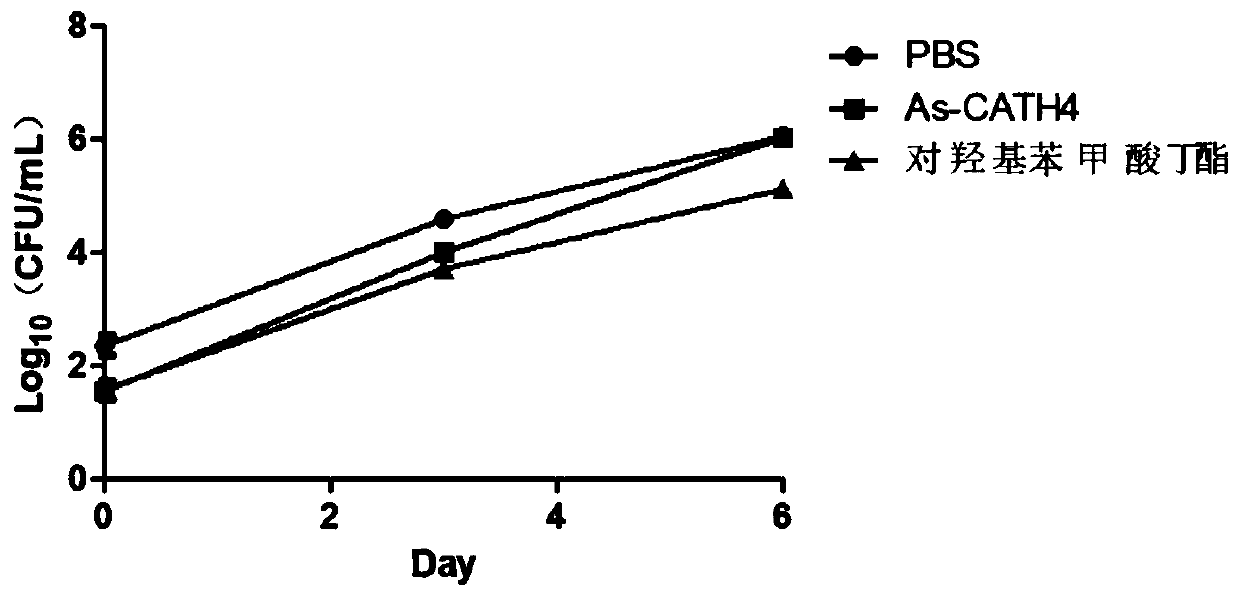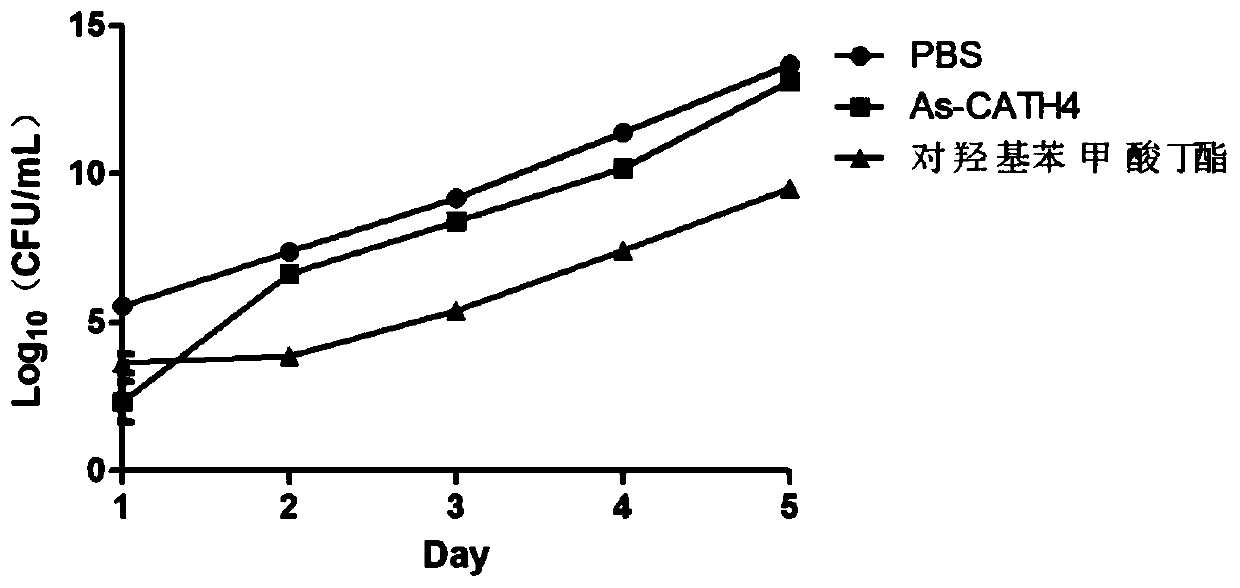Application of natural antibacterial peptide As-CATH4 in food preservation and fresh-keeping
A technology of food preservation and food preservatives, which is applied in the field of food chemistry and can solve problems such as degradation, narrow antibacterial spectrum, and poor stability of antimicrobial peptides
- Summary
- Abstract
- Description
- Claims
- Application Information
AI Technical Summary
Problems solved by technology
Method used
Image
Examples
Embodiment 1
[0024] Preparation of As-CATH4
[0025] (1) The chemical synthesis method of As-CATH4: the complete sequence of As-CATH4 was synthesized by an automatic peptide synthesizer (433A, Applied Biosystems), and desalted and purified by HPLC reverse-phase column chromatography.
[0026] (2) The molecular weight was determined by matrix-assisted laser desorption ionization time-of-flight mass spectrometry (MALDI-TOF).
[0027] (3) The purity of the purified As-CATH4 is identified by high performance liquid chromatography (HPLC), the molecular weight is determined by matrix-assisted laser desorption ionization time-of-flight mass spectrometry (MALDI-TOF), the isoelectric point is determined by isoelectric focusing electrophoresis, and automatic amino acid sequencing is used Determination of amino acid sequence structure.
[0028] The natural antibacterial peptide As-CATH4 is composed of 38 amino acids, with a molecular weight of 4402.5Da and an isoelectric point of 12.78. The amino a...
Embodiment 2
[0031] Detection of antibacterial activity of As-CATH4 against common spoilage bacteria:
[0032] Determined by the minimum inhibitory concentration method. Select fish spoilage strains for MIC determination experiment. The test strains were inoculated into MH liquid medium (OXOID, UK), cultured with shaking at 37°C to the logarithmic growth phase, and then diluted to 2×10 with fresh MH liquid medium to the logarithmic growth phase. 5 CFU / ml for use.
[0033] Add 100 μl of LB liquid medium in advance to each well of a sterile 96-well plate, and then add 100 μl of As-CATH4 sample solution diluted to a certain concentration with MH liquid medium to the first well and filtered through a 0.22 μm filter membrane, After mixing evenly, take 100 μl and add it to the second well, serially dilute (see Table 1), suck out 100 μl from the ninth well and discard, and the tenth well is a control tube.
[0034] Table 1 Dilution method
[0035]
[0036] The 96-well plate was cultured at...
Embodiment 3
[0041] Determination of As-CATH4 sterilization speed:
[0042] Select four strains of spoilage bacteria (Acinetobacter Jones, Shewanella algae, Proteus mirabilis, and Bacillus subtilis) and culture them with MH liquid medium (OXOID, UK) at 37°C for 12 hours, and then culture them with fresh MH liquid base diluted to 10 6 CFU / ml bacterial suspension. The As-CATH4 sample dissolved in sterilized deionized water was added to the bacterial suspension so that the final concentration was 5×MIC. Place the bacterial solution added with the As-CATH4 sample in a 37°C incubator for shaking culture, take 10 μl of the bacterial solution to dilute 1000 times at 0, 15, 30, 60, 90, 120 and 180 minutes, and then take 50 μl of the diluted bacterial solution Spread it on the MH solid medium plate, and count the colonies after culturing overnight in a 37°C incubator. The experiment used butylparaben as a positive control and sterile deionized water as a negative control.
[0043] The results a...
PUM
| Property | Measurement | Unit |
|---|---|---|
| Molecular weight | aaaaa | aaaaa |
Abstract
Description
Claims
Application Information
 Login to View More
Login to View More - R&D
- Intellectual Property
- Life Sciences
- Materials
- Tech Scout
- Unparalleled Data Quality
- Higher Quality Content
- 60% Fewer Hallucinations
Browse by: Latest US Patents, China's latest patents, Technical Efficacy Thesaurus, Application Domain, Technology Topic, Popular Technical Reports.
© 2025 PatSnap. All rights reserved.Legal|Privacy policy|Modern Slavery Act Transparency Statement|Sitemap|About US| Contact US: help@patsnap.com



